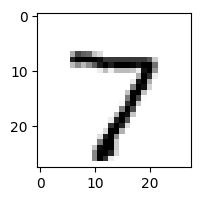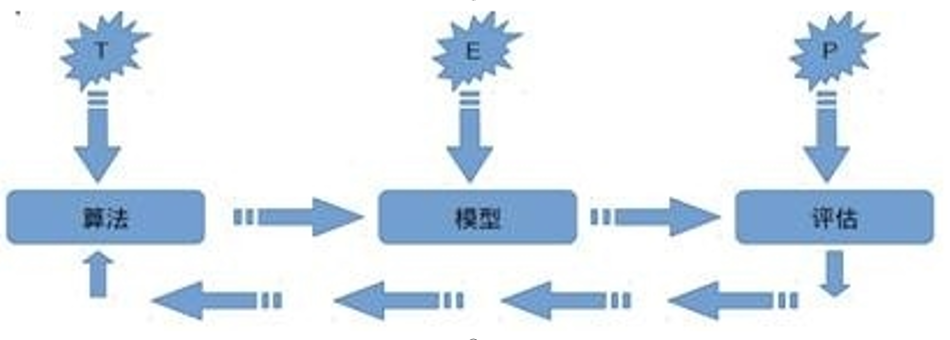文章目录
- 总结
- 参考
- 本门课程的目标
- 机器学习定义
- 第一步:数据准备
- 第二步:定义网络
- 第三步:训练网络
- 第四步:测试训练好的网络
总结
本系列是机器学习课程的系列课程,主要介绍基于paddle实现神经网络。
参考
MNIST 训练_副本
本门课程的目标
完成一个特定行业的算法应用全过程:
懂业务+会选择合适的算法+数据处理+算法训练+算法调优+算法融合
+算法评估+持续调优+工程化接口实现
机器学习定义
关于机器学习的定义,Tom Michael Mitchell的这段话被广泛引用:
对于某类任务T和性能度量P,如果一个计算机程序在T上其性能P随着经验E而自我完善,那么我们称这个计算机程序从经验E中学习。
使用MNIST数据集训练和测试模型。
第一步:数据准备
MNIST数据集
import paddle
from paddle.vision.datasets import MNIST
from paddle.vision.transforms import ToTensortrain_dataset = MNIST(mode='train', transform=ToTensor())
test_dataset = MNIST(mode='test', transform=ToTensor())展示数据集图片
import matplotlib.pyplot as plt
import numpy as nptrain_data0, train_label_0 = train_dataset[0][0], train_dataset[0][1]
train_data0 = train_data0.reshape([28, 28])
plt.figure(figsize=(2, 2))
plt.imshow(train_data0, cmap=plt.cm.binary)
print('train_data0 的标签为: ' + str(train_label_0))
/opt/conda/envs/python35-paddle120-env/lib/python3.7/site-packages/matplotlib/__init__.py:107: DeprecationWarning: Using or importing the ABCs from 'collections' instead of from 'collections.abc' is deprecated, and in 3.8 it will stop workingfrom collections import MutableMapping
/opt/conda/envs/python35-paddle120-env/lib/python3.7/site-packages/matplotlib/rcsetup.py:20: DeprecationWarning: Using or importing the ABCs from 'collections' instead of from 'collections.abc' is deprecated, and in 3.8 it will stop workingfrom collections import Iterable, Mapping
/opt/conda/envs/python35-paddle120-env/lib/python3.7/site-packages/matplotlib/colors.py:53: DeprecationWarning: Using or importing the ABCs from 'collections' instead of from 'collections.abc' is deprecated, and in 3.8 it will stop workingfrom collections import Sized
/opt/conda/envs/python35-paddle120-env/lib/python3.7/site-packages/matplotlib/cbook/__init__.py:2349: DeprecationWarning: Using or importing the ABCs from 'collections' instead of from 'collections.abc' is deprecated, and in 3.8 it will stop workingif isinstance(obj, collections.Iterator):
/opt/conda/envs/python35-paddle120-env/lib/python3.7/site-packages/matplotlib/cbook/__init__.py:2366: DeprecationWarning: Using or importing the ABCs from 'collections' instead of from 'collections.abc' is deprecated, and in 3.8 it will stop workingreturn list(data) if isinstance(data, collections.MappingView) else data
/opt/conda/envs/python35-paddle120-env/lib/python3.7/site-packages/matplotlib/image.py:425: DeprecationWarning: np.asscalar(a) is deprecated since NumPy v1.16, use a.item() insteada_min = np.asscalar(a_min.astype(scaled_dtype))
/opt/conda/envs/python35-paddle120-env/lib/python3.7/site-packages/matplotlib/image.py:426: DeprecationWarning: np.asscalar(a) is deprecated since NumPy v1.16, use a.item() insteada_max = np.asscalar(a_max.astype(scaled_dtype))train_data0 的标签为: [5]
第二步:定义网络
import paddle
import paddle.nn.functional as F
from paddle.nn import Conv2D, MaxPool2D, Linearclass MyModel(paddle.nn.Layer):def __init__(self):super(MyModel, self).__init__()self.conv1 = paddle.nn.Conv2D(in_channels=1, out_channels=6, kernel_size=5, stride=1, padding=2)self.max_pool1 = MaxPool2D(kernel_size=2, stride=2)self.conv2 = Conv2D(in_channels=6, out_channels=16, kernel_size=5, stride=1)self.max_pool2 = MaxPool2D(kernel_size=2, stride=2)self.linear1 = Linear(in_features=16*5*5, out_features=120)self.linear2 = Linear(in_features=120, out_features=84)self.linear3 = Linear(in_features=84, out_features=10)def forward(self, x):x = self.conv1(x)x = F.relu(x)x = self.max_pool1(x)x = F.relu(x)x = self.conv2(x)x = self.max_pool2(x)x = paddle.flatten(x, start_axis=1, stop_axis=-1)x = self.linear1(x)x = F.relu(x)x = self.linear2(x)x = F.relu(x)x = self.linear3(x)return x模型可视化
import paddle
mnist = MyModel()
paddle.summary(mnist, (1, 1, 28, 28))
---------------------------------------------------------------------------Layer (type) Input Shape Output Shape Param #
===========================================================================Conv2D-1 [[1, 1, 28, 28]] [1, 6, 28, 28] 156 MaxPool2D-1 [[1, 6, 28, 28]] [1, 6, 14, 14] 0 Conv2D-2 [[1, 6, 14, 14]] [1, 16, 10, 10] 2,416 MaxPool2D-2 [[1, 16, 10, 10]] [1, 16, 5, 5] 0 Linear-1 [[1, 400]] [1, 120] 48,120 Linear-2 [[1, 120]] [1, 84] 10,164 Linear-3 [[1, 84]] [1, 10] 850
===========================================================================
Total params: 61,706
Trainable params: 61,706
Non-trainable params: 0
---------------------------------------------------------------------------
Input size (MB): 0.00
Forward/backward pass size (MB): 0.06
Params size (MB): 0.24
Estimated Total Size (MB): 0.30
---------------------------------------------------------------------------{'total_params': 61706, 'trainable_params': 61706}
第三步:训练网络
import paddle
from paddle.metric import Accuracy
from paddle.static import InputSpecinputs = InputSpec([None, 784], 'float32', 'x')
labels = InputSpec([None, 10], 'float32', 'x')# 用Model封装模型
model = paddle.Model(MyModel(), inputs, labels)# 定义损失函数
optim = paddle.optimizer.Adam(learning_rate=0.001, parameters=model.parameters())# 配置模型
model.prepare(optim, paddle.nn.CrossEntropyLoss(), Accuracy())
# 训练模型
model.fit(train_dataset, test_dataset, epochs=3, batch_size=64, save_dir='mnist_checkpoint', verbose=1)The loss value printed in the log is the current step, and the metric is the average value of previous steps.
Epoch 1/3
step 938/938 [==============================] - loss: 0.0208 - acc: 0.9456 - 34ms/step
save checkpoint at /home/aistudio/mnist_checkpoint/0
Eval begin...
step 157/157 [==============================] - loss: 0.0041 - acc: 0.9777 - 19ms/step
Eval samples: 10000
Epoch 2/3
step 938/938 [==============================] - loss: 0.0021 - acc: 0.9820 - 34ms/step
save checkpoint at /home/aistudio/mnist_checkpoint/1
Eval begin...
step 157/157 [==============================] - loss: 2.1037e-04 - acc: 0.9858 - 19ms/step
Eval samples: 10000
Epoch 3/3
step 938/938 [==============================] - loss: 0.0126 - acc: 0.9876 - 34ms/step
save checkpoint at /home/aistudio/mnist_checkpoint/2
Eval begin...
step 157/157 [==============================] - loss: 4.7168e-04 - acc: 0.9884 - 19ms/step
Eval samples: 10000
save checkpoint at /home/aistudio/mnist_checkpoint/final
第四步:测试训练好的网络
import paddle
import numpy as np
import matplotlib.pyplot as plt
from paddle.metric import Accuracy
from paddle.static import InputSpecinputs = InputSpec([None, 784], 'float32', 'x')
labels = InputSpec([None, 10], 'float32', 'x')
model = paddle.Model(MyModel(), inputs, labels)
model.load('./mnist_checkpoint/final')
model.prepare(optim, paddle.nn.CrossEntropyLoss(), Accuracy())# results = model.evaluate(test_dataset, batch_size=64, verbose=1)
# print(results)results = model.predict(test_dataset, batch_size=64)test_data0, test_label_0 = test_dataset[0][0], test_dataset[0][1]
test_data0 = test_data0.reshape([28, 28])
plt.figure(figsize=(2,2))
plt.imshow(test_data0, cmap=plt.cm.binary)print('test_data0 的标签为: ' + str(test_label_0))
print('test_data0 预测的数值为:%d' % np.argsort(results[0][0])[0][-1])Predict begin...
step 157/157 [==============================] - 27ms/step
Predict samples: 10000
test_data0 的标签为: [7]
test_data0 预测的数值为:7/opt/conda/envs/python35-paddle120-env/lib/python3.7/site-packages/matplotlib/image.py:425: DeprecationWarning: np.asscalar(a) is deprecated since NumPy v1.16, use a.item() insteada_min = np.asscalar(a_min.astype(scaled_dtype))
/opt/conda/envs/python35-paddle120-env/lib/python3.7/site-packages/matplotlib/image.py:426: DeprecationWarning: np.asscalar(a) is deprecated since NumPy v1.16, use a.item() insteada_max = np.asscalar(a_max.astype(scaled_dtype))


的mysql驱动(附带编译后的全部文件))











)



)


